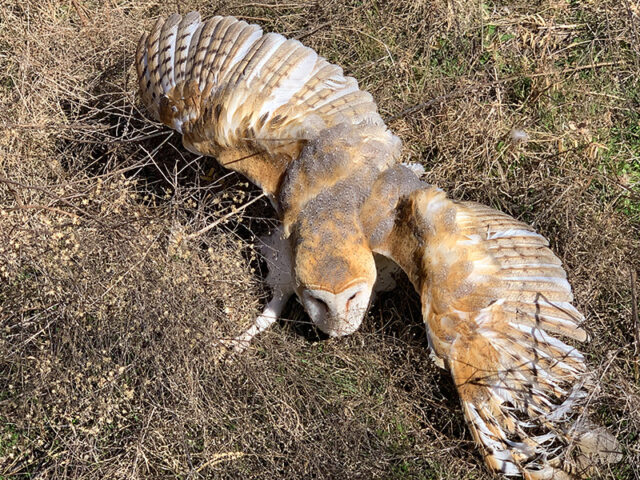Dateline – December 26, 2020 – Carrollton, Texas

I was on a short hike this sunny winter afternoon when an unusual looking patch of white caught my attention. Starkly out of place against the grays and tans of North Texas winter, the object was still far enough away that I could not be sure what it was.
The impression of a Barn Owl briefly crossed my mind, but I quickly dismissed the thought… What would a Barn Owl be doing on the ground, in the middle of the day? Why was he in such and odd pose? And why wasn’t he moving. Surely, this was just a wind blown piece of paper coincidentally arranged to resemble the shape of an owl.
Then as I peered through the brush—still attempting to identify this out-of-place discovery—the poor bird raised its head and looked right at me. I instantly recognized the dark eyes and distinctive heart shaped face. This was a Barn Owl! But what was he doing here like this? And why didn’t he flush when he saw me coming?
Maybe the owl was in the process of subduing a prey animal, and was reluctant to leave and give it a chance to escape? That was the best explanation I could think of, but I was skeptical. I cautiously moved closer for a better look. It didn’t take long to see that something was seriously wrong.
The owl was not actually on the ground. Instead, he was suspended several inches off the ground barely supported by the prairie vegetation. His left wing was stretched out oddly, pointing straight toward the sky.

On closer inspection, it became clear that the owl had tangled itself in some kind of twine and was in a serious bind. Now I was really concerned. If the string had wrapped tightly around the birds body or wing there could be serious injury. If the owl had struggled for an extended time there could be deep lacerations or broken bone.

Fortunately, it quickly became apparent that things were not as bad as they might have been. The twine was kite string that had stretched across the tops of several Mesquite trees when the toy was lost. The owl had somehow managed to tangle the string around the ends of its primary flight feathers five of six times, but the evidence suggested that he has only been in this predicament for a few hours.
I quickly pulled out my handy Swiss Army Knife and used the scissor tool to free the owl from the length of the string connecting him to the tree. I lifted him up by his wing tip to have a closer look at the cord wrapped around his feathers. While I was busy sizing up the situation, the owl reached out and grabbed at my shirt with his talons. Barn Owl talons are very sharp. This is a fact that me and my newly pierced bellybutton can positively attest to.
Once again, I went to work with the scissor tool, and soon the owl was completely free. A couple of the owl’s feathers had been damaged to a degree by the twine, but I judged that they were not so bad that he would not be able to fly. I lowered the bird to the ground and stepped back so that he could take to the air.
Even though there was no obvious injury, the Barn Owl did not take to the air as I had hoped. Instead, he just sat right on the ground in a defensive posture. Understandable, right? He was probably very tired from his struggles with the string. It was possible he just needed a little time to recover from his ordeal, so I went on my way, hoping the owl would go ahead and fly off in my absence.

About a half hour later, as I was hiking back out, I stopped by to check on the owl again. I was disheartened to find him still in the same place and in the same general condition.
But something had changed… The owl now had a little fight in him.
I encouraged the owl to take flight, but he just stood there shaking his head at me. This was not the owl being difficult… this was a defensive behavior known as “toe dusting.” It’s a weird thing Barn Owls do when feeling threatened.

I resigned myself to the idea that this owl was going to have to go to a rehab facility. I removed my outer shirt, planning to use it in an attempt to capture the bird. Covering the eyes of the owl would encourage the bird to be docile, and it would also help me keep control of his large wingspan and sharp talons. As I moved forward with my shirt in hand, the owl responded by leaping into the air and flying off.
Even though a few of the owl’s feathers were a little worse for the wear, it was clear he was still able to fly competently. This was good news, and was the outcome I was hoping for! The owl had just needed some rest. He had survived his ordeal with minimal damage, and was still able to fly.
This owl will certainly have challenges compensating for his damaged flight feathers going forward, but I like his chances for survival. And the good news is that the bad feathers will be replaced in their entirety during the owl’s next annual molt. That will give him a fresh start, and a new lease on life.







